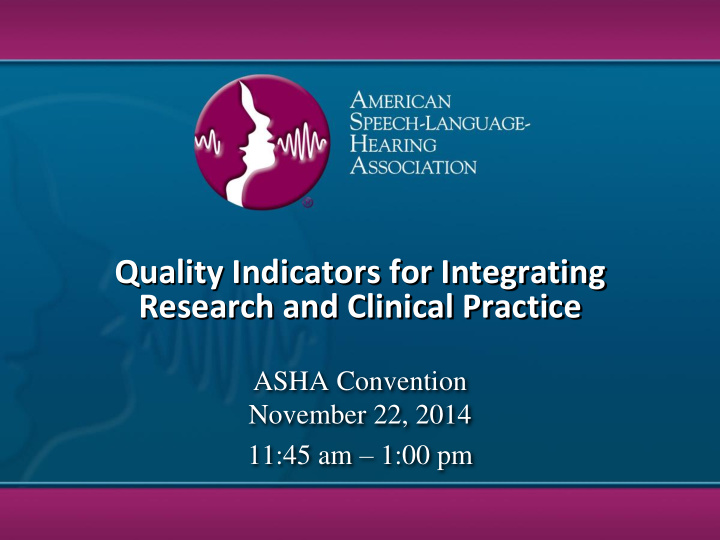



Quality Indicators for Integrating Research and Clinical Practice ASHA Convention November 22, 2014 11:45 am – 1:00 pm
Karen Beverly-Ducker , MA, CCC-A ASHA Director, Multicultural Resources kbeverlyducker@asha.org Diane Paul, PhD, CCC-SLP ASHA Director, Clinical Issues in Speech-Language Pathology dpaul@asha.org
Disclosures Diane Paul Financial: ASHA Employee Non Financial: ASHA Member Member of ASHA Quality Indicators Team Karen Beverly-Ducker Financial: ASHA Employee Non Financial: ASHA Member Member of ASHA Quality Indicators Team
ASHA Quality Indicators Team • Froma Roth, Team Leader • Karen Beverly-Ducker • Paul Farrell • Diane Paul • Mary Raucci • Sarah Slater • Becky Venediktov
History of the Quality Indicators • Originally developed in 2006 • Focused Initiative on Addressing the PhD Shortage • Purpose: “develop a self -assessment for CSD programs to gauge integration of research and clinical practice”
Development • Three-year project (2012 – 2014) • Strategic Pathway Objective 4: Increasing Accessibility and Use of Research • Charge: “to update and redistribute the QIs on the use of EBP to inform clinical decision- making” • Deliverables = revised/updated QIs & enhanced/new resources
OVERVIEW • Year 1: review, revise & update • Year 2: disseminate • Year 3: evaluate & ID next steps • In scope – develop/revise QIs, ID existing resources, market research, collect data, disseminate • Out of scope – large scale studies, uniform plan for use, tracking, other research, program evaluation
OVERVIEW 2012 • Review and revise to incorporate EBP triangle into QIs • Focus Group at convention • Peer Reviewers 2013 • QIs modified • Identified CSD programs to pilot • Modified Action Plan form • Piloted program 2014 • Survey • Blog developed • Plans for follow up with pilot program participants • Identify and develop resources
Screen Shot of Quality Indicators www.asha.org/academic/teach-tools/QIAssess/
Quality Indicators • What motivated you to attend this session? • Have participants used the quality indicators? • If so, what is your experience?
Audience Experiences Discuss experience with self-assessment
Updated Self-Assessment 1. Changed answer key Added yes/no option 2. Reduced the length 40 to 30 items Omitted redundant items 3. Refined and added questions 4. Provided a comment section
Updated Self-Assessment 5. Offered online fillable form 6. Provided sample timeline 7. Provided more guidance on ways to use the self-assessment
Screen Shot of Action Plan www.asha.org/academic/teach-tools/QIAssess/
Audience Experience Discuss experience with action plan development.
Retooled Action Plan Desire for fluid process from Quality Indicators to Action Plan • Provided suggested steps • Added section for prioritizing goals • Tied directly to the needs identified from the quality indicators
Quality Indicators for Integrating Research and Clinical Practice - Pilot Program Evaluation Survey Results (October 2014) Survey Participants Six institutions provided feedback on the pilot program for a 75% response rate.
Action Plan Development • 66.7% developed an action plan (4) • 50% developed using the template provided in the ASHA Quality Indicators self- assessment tool. • Developed by program director, academic and clinical faculty (66.2%), or a department curriculum committee. • No students were involved.
Survey Results • Time to develop action plan 2-4 hours • Challenges Attaining achievable steps based upon time demands of faculty (teaching/supervision, research, service). Thinking about how to incorporate these new objectives into course syllabi
Action Plan Goals Range: 2-4 goals • GOAL: Increase collaboration between faculty in and outside the departments. OBJECTIVE: Create collaborative on-going research with master's level and doctoral level faculty within the department. • GOAL: Curriculum review • OBJECTIVE 1: Undergraduate and graduate curriculum reviewed for alignment with current practice and ASHA standards. • OBJECTIVE 2: Identify courses to be modified, discontinued, and added at the undergraduate and graduate level.
Areas Targeted for Change • Curriculum (100%) • Course work (66.7%) • Faculty preparation, students, clinical practicum (33.3%)
Implementation Challenges • Knowledge gap for some master's level faculty regarding implementation of evidence-based practice • Time to collaborate
Next Steps Proposed for ASHA • ASHA training modules on ways to implement evidence-based practice • Continue to stress the importance of integrating research and practice, highlighting examples on the web and in other electronic publications
Future Use of Self-Assessment and Action Plan • Addition to student learning outcomes • Consider quality indicators when revisions are made to graduate curriculum • On-going review of current practice within the department and revision of action plan as necessary • Periodically re-administer due to faculty turnover • Separate responses from faculty and students when self-assessment is administered
Discussion Questions • What are challenges associated with incorporating EBP? • Do students apply EBP in their clinical work? • How can we improve student implementation of EBP in onsite and external clinics?
www.asha.org/academic/teach-tools/QIAssess For more information, contact Froma Roth at froth@asha.org
Recommend
More recommend